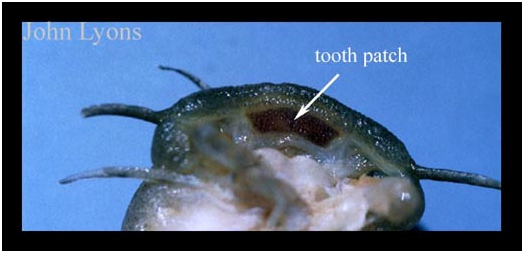Classification
Kingdom: Animalia
Phylum: Chordata
Supergroup: Osteichthyes
Class: Actinoptergii
Order: Silurformes
Family: lctaluridae
Genus: Noturus
Species: N. exilis
~~~~~~~~~~~~~~~~~~~~~~~~~~~~~~~~~~~~~~
Domain: Eukarya
Eukarya are organisms that contain a membrane-bound nucleus containing the DNA of that organism and membrane-bound organelles (Hickman 2012). They tend to have organelles such as mitochondria, lysosomes, vacuole, and Golgi apparatus.
Kingdom: Animalia
The Animal Kingdom tends to contain organisms that are multicellular and contain eukaryotic cells. Eukaryotic cells are cells that have a membrane-bound nucleus. Animals tend to be heterotrophic, which means they acquire energy from the consumption of other organisms (Hickman 2012). Animals also have a distinct stage of development. Animals in the Animal Kingdom go through a blastula stage. This is an early embryonic stage consisting of a hollow mass of cells (Hickman 2012). These animals are bilateral and triploblastic organisms. Triploblastic refers to an organism with 3 germ layers. These three germ layers are ectoderm, endoderm, and mesoderm (Hickman 2012).
Phylum: Chordata
Chordates consist of all the vertebrates and some strongly related invertebrates. Chordates tend to have an endoskeleton, complete digestive system, and a tail at some stage in their life (Hickman 2012). A prime characteristic of chordates is the notochord. The notochord can stay with the animal their entire life or for only a part their early life. Its main function is to stiffen the body, which provides skeletal situate for the attachment of swimming muscles (Hickman 2012). Chordates are also deuterstomes. Deuterstomes have radial cleavage which is the beginning development describing the way that the blastula divides. It divides symmetrically according to the polar axes and creates a new blastomere (Hickman 2012). Chordates also contain a dorsal tubluar nerve cord, which is a bunch of nerves the go down the dorsal part of the body. There are three subphylums: tunicata, cephalochordata, and vertebrata. The slender madtom falls in the vertebrata subphylum (Hickman 2012).
Superclass: Osteichthyes
Osteichthyes are the boneyfish. This is referring to having an endochondral bone instead of cartilage. This super class has large numbers and a wide variety of animals and large numbers of animals (Hickman 2012).
Class: Actinopterygii
Actinoptergii are the ray-finned fish. This class contains fish that have lepidotrichia or fin rays. The Actinopterygii contains the subclasses Chondrostei and Neopterygii. The slender madtom is part of the Neopterygii subclass. Some characteristics of the neoptygii tend to be quicker and have a stronger jaw than those before them (Hickman 2012). The neoptrygii then has two infraclasses. They are the Holosteri and Teleosteri. The slender madtom is part of the Teleostei infraclass (Hickman 2012). This infraclass is the largest of the infraclasses and is characterized by their light, thin flexible cycloid and ctenoid scales. They also have more of a symmetrical shape of their homocercal. These traits increase speed and ability to move (Hickman 2012).
Order: Siluriformes
The order Siluriformes are the catfish. They are primarily recognized by their barbels (Encyclopedia of Life 2013). These are the projections on their face that look like whiskers, like a cat, hence the common name cat fish. Some other defining features are the skull and swimbladder . The skull makes a distinctive shape. Also, most Siluriformes are nocturnal (Encyclopedia of Life 2013).
Family: Ictaluridae
Ictaluridae is a family of catfish that are native to North America. They are a significant food fish and some are sport fish. This family includes bullheads, channel catfish, and blue catfish (Encyclopedia of Life 2013). Their determining characteristics are four pairs of barbels and no scales. Most of the time the dorsal and pectoral fins have spines and their palate is toothless. The slender madtom is one of the smaller fish, the Ictaluridae (Encyclopedia of Life 2013).
Genus: Noturus
Noturus is a genus made up of small catfish, or madtoms. Madtoms tends to look similar to each other. They have a shortened tail fin and tend to have a brownish yellow pattern on them. Some are also toxic at certain points on their fins, which result in a stinging feeling (Encyclopedia of Life 2013).
Species: Noturus exilis
The Noturus exilis is also known as the slender madtom. This species of madtom is separated from the rest because it has an adipose fin that is connected to the back and caudal fin (Introduction to Missouri's Fishes 2005).
The classification of the slender madtom is important for understanding its links to evolution. Next let's take a look at their habitat or you may head back to the homepage.


